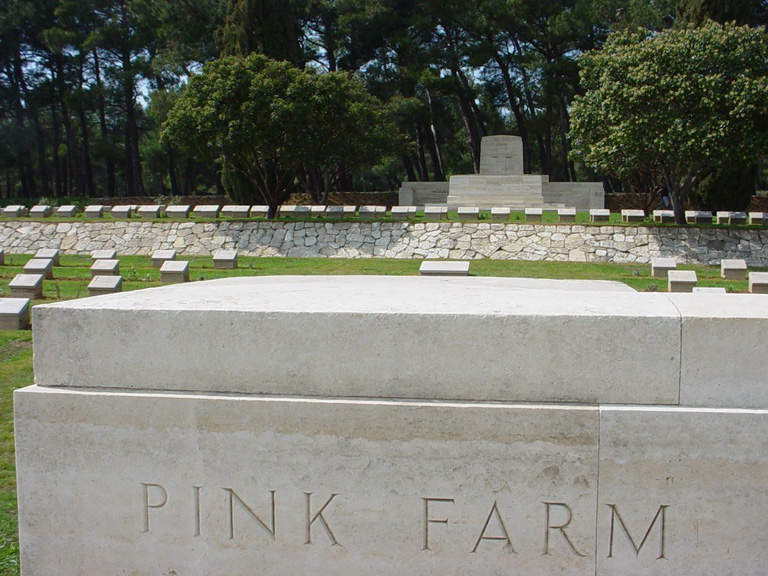Pink Farm Cemetery, Helles
- Country Turkey (including Gallipoli)
- Total identified casualties 352 Find these casualties
- Identified casualties from First World War
- GPS Coordinates Latitude: 40.07253, Longitude: 26.19096
Statement from the CWGC regarding fires in Gallipoli
The Commonwealth War Graves Commission (CWGC) is deeply concerned to learn that large fires, reportedly started by an electrical fault, have burnt historical areas of the Gallipoli peninsula in Türkiye.
Location information
Follow the road to Helles opposite the Kabatepe Museum. At 14.2km's take a right turn at the 'T' junction and at 14.3km's take the left fork. After a total of 18.2km's, Pink Farm Cemetery will be found down a short track on your left. Pink Farm was a building about 1800 metres south-west of the Redoubt, on the road from Sedd el-Bahr to Geoghegan's Bluff.
Visiting information
The Cemetery is permanently open and may be visited at any time.
Please note that in the absence of a cemetery register, visitors are advised to locate the Grave/Memorial reference before visiting. This information can be found in the CASUALTY RECORDS within this page.
For further information and enquiries please contact enquiries@cwgc.org
History information
The eight month campaign in Gallipoli was fought by Commonwealth and French forces in an attempt to force Turkey out of the war, to relieve the deadlock of the Western Front in France and Belgium, and to open a supply route to Russia through the Dardanelles and the Black Sea.
The Allies landed on the peninsula on 25-26 April 1915; the 29th Division at Cape Helles in the south and the Australian and New Zealand Corps north of Gaba Tepe on the west coast, an area soon known as Anzac.
On 28 April, following the landings at Helles, the first attack was mounted towards Achi Baba, the ridge which dominates the southern part of the peninsula. Fatigue, however, brought the assault to a halt some kilometres short of the objective, near the village of Krithia. Turkish counter attacks followed but were repulsed and during the period 6-8 May, the 29th and French Divisions, reinforced by the 2nd Australian and New Zealand Infantry Brigades, carried out a renewed attack on Krithia, making some gains but suffering heavy casualties.
Between 1 May and the beginning of June, the 29th Indian Infantry Brigade and 42nd (East Lancashire) Division landed on the peninsula. With these reinforcements, the Allied force at Helles pushed forward once more on 4 June, but again to little effect. A further attack between 28 June and 5 July at Gully Ravine inflicted heavy casualties on the Turkish forces, but despite local gains - at one point the line was pushed forward more than a kilometre - there was no breakthrough. By 13 July the advance at Helles was effectively over and the position remained unchanged until the evacuation in January 1916.
Pink Farm (properly Sotiri Farm) took its name from the red soil of the area. Three cemeteries eventually grew up round the farm, the first began after the First Battle of Krithia (28 April 1915). After the armistice, the three cemeteries (Pink Farm Nos. 1, 2 and 3) were combined on the site of No.3 (Plot III and part of Plot IV of the present cemetery are the original graves from No.3) and graves from the following smaller cemeteries were added:-
29th Divisional, 52nd Divisional, Aerodrome, Oak Tree, Gully Beach and Gully Farm.
There are now 602 servicemen of the First World War buried or commemorated in this cemetery. 250 of the burials are unidentified, but special memorials commemorate 219 casualties known or believed to be buried among them.



